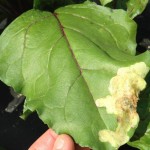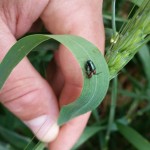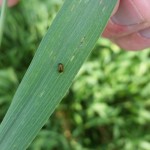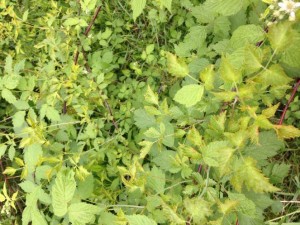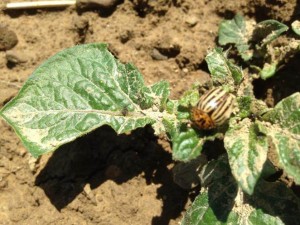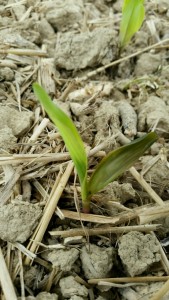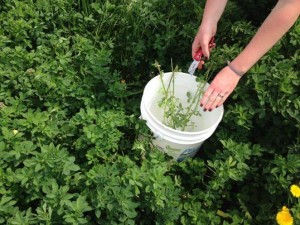Vegetables:
Most vegetable plantings look good and some growers were being encouraged to keep up with watering, especially new transplants. The rain received on the nights of May 26 and 27 was needed and appreciated. The range of vegetables being scouted includes: asparagus, onions, garlic, radishes, beets, peas, potatoes, lettuce, cabbage, cauliflower, broccoli, tomatoes, squash, pumpkins, zucchini, melons, sweet corn peppers, eggplant, green snap beans, and some Asian greens.
At this point field tomatoes look good and no insect or disease problems have been detected. In high tunnel tomatoes however scouts have found in some tunnels botrytis gray mold, leaf mold and just this week the first symptoms of early blight. (See photo below) Some high tunnel tomato fruit is showing zippering and catfacing. Growers are being encouraged to prune tomatoes to allow for better air movement and prevent disease development.
Thrips are being found below economic treatment thresholds on some onions and garlic. Flea beetles are currently feeding on and being detected on a number of vegetable crops including radishes, cole crops, eggplant, and potatoes. Levels have been light, below economic treatment thresholds. Colorado potato beetle (CPB) is being found in potatoes with increasing frequency and in increasing numbers. Scouts are finding adults and egg masses. A few fields were approaching threshold treatment levels. Scouts found some early instar caterpillars on cabbage this week and expect that those numbers will increase in coming weeks. One of the scouts found leaf damage by leaf miners in beets. See attached photo by IPM scout Chris Smedley.
Squash, Zucchini and cucumbers in some fields were reported to be in bloom and fruit set was beginning. For the most part these crops are pest free at this point but scouts did find some angular leaf spot, a bacterial disease, in one planting and cucumber beetles are beginning to show up more frequently. Numbers of cucumber beetles are still very low, below economic treatment thresholds. Scouts found leaf defoliation damage by bean leaf beetles on some green snap bean plantings this week. Defoliation ranged from slight up to 30% damage. Slugs were also noted as causing some light leaf feeding injury.
Sweet corn is progressing well and growers continue to plant so there is a range of staggered planting dates. Corn maturity ranges from just planted to emerging and up to the V-6 stage of growth. Some slug damage has been noted with 2-9% leaf feeding damage, black cutworms are present at low levels and only causing leaf feeding damage with some fields exhibiting 3-5% leaf feeding. No cut plants have been observed to this point. Scouts did find a couple of early instar armyworm larvae in one sweet corn field and will be watching for any increases and possible damage in coming weeks.
Fruit:
Based on trap catches, we have two different biofix dates for codling moth in apples and oriental fruit moth in peaches. The southern end of Wayne County and orchards in northern Holmes County have a 7-10 day earlier biofix date depending upon the species as compared to orchards in northern Wayne and southern Medina County. Growers are currently applying protective insecticide treatment sprays for those insects based on growing degree day (GDD) accumulated since biofix.
In small fruit many strawberries are turning color and we could see some ripe strawberries the week of June 1. Scouts are noting some light slug feeding damage, some spittle bugs and some leaf spot in some strawberry plantings. Grapes at this point look good and growers are being encouraged to keep up with an early season spray schedule. All growers have been provided with excellent information written by Mike Ellis, (emeritus OSU Extension fruit disease specialist) about early season disease control. Raspberries and blackberries are at bloom and fruit development stage of growth. Orange rust is showing up in some plantings. Blueberries look good and are at bloom and fruit development. There are some light levels of phomopsis twig blight being noted in some plantings.
Agronomic Field Crops:
Corn overall looks very good and growth stage ranges from V-1 to V-4. Scouts are noting light slug damage leaf feeding ranging from 3 to 15% on some fields. Black cutworm leaf feeding was noted on some fields at up to 15% damage and in other fields actual cut plants were noted at 1% levels. The black cutworm larvae that were found were 1.25 inches in size, indicating a late instar stage and larvae at the end of their feeding cycle and about to pupate. Weed control is generally good but some grassy weeds and Canada thistle patches noted in some fields. As well one of the scouts found cereal leaf beetles in wheat. (See photos below)
Most soybean fields are at emergence to V-c stage of development and at this point no disease or insect pest issues. Alfalfa is re-growing following last week’s harvest cut and no pest problems noted.
Photos by Kate Fike, Chris Smedley and Austin Pelyak
Botrytis Gray Mold
Leaf damage by leaf miners in beets.
Cereal Leaf Beetle

